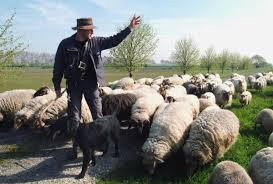You can also go out as shepherd with the herd. The Border Collie is the most widely used sheepdog. There are even competitions organized for herding. To make a change of direction to straying sheep also a crook was used with a small trowel on top. With this a bunched earth was targeted to the sheep.
A wolf stays away from barking herd surveillance dogs such as the Pyrenean mountain dog, Hungarian Kuvasz and Maremmano.
Sheepdogs guarding remote flocks of sheep sometimes receive a spine collar for protection against wolves (CoyoteCollar or Carlanca, or wolf collar to protect guardian dogs from attacking wolves). The pins point outwards (in contrast to copies sold "for training purposes" - some of which can also be turned inside out).
 In a herd often one black sheep was held. That was to attract all the evil, and keep the rest of the herd healthy. Of course such a scapegoat always extra stands out in a herd.
In a herd often one black sheep was held. That was to attract all the evil, and keep the rest of the herd healthy. Of course such a scapegoat always extra stands out in a herd.
Scientists have found the way a dog is driving a flock through mathematically computer analyzes. The final conclusion is surprisingly simple, and useful to manipulate groups (including poultry, fish, people,...). Drive them together first, as compact as possible. Therefore they will respond as a group. And you can steer them.
The bellwether is a cut (castrated) ram that leads a herd with the bell.
You can also herd cows, geese....
The herd walk used to be the daily grazing tour led by the shepherd reimbursed by the participants. In the morning, villagers brought their geese, sheep, cows, all grass-fed cattle together on a (often triangular) plaza. Children could also go with family cattle. The animals then had to leave the village quickly, so that they did not end up in the enclosed gardens and meadows. They did not return until evening.
The residents jointly had the right to graze or herd their animals on the surrounding 'common' grounds (wild grasslands, roadsides, heaths or forests). The old word "heerd" means not only 'flock' but also 'shepherd'. In many villages, including Haspengouw, street names still refer to the routes that were followed. (Sheep's fur (and hooves) in particular have spread many weed seeds on these routes.)
The principle was also applied in other countries. The "commons" were resources to be used by members of the group. Also watering or irrigation, coppice, a village bread oven or village pump were often managed in this way.
In Ghent, Antwerp, Rotterdam a shepherd with a herd of sheep is active for the ecological maintenance of nature domains, public and private, roadsides, along roads, motorways, bridges and ecoducts, business sites, dikes, near canals and rivers, e.g. fighting Japanese knotweed, rest homes, parks and gardens around campus, natural grasslands, forest edges, near forests, forts, tank canals ..., solar panel parks, noise barriers, nature cemeteries, golf courses ...
